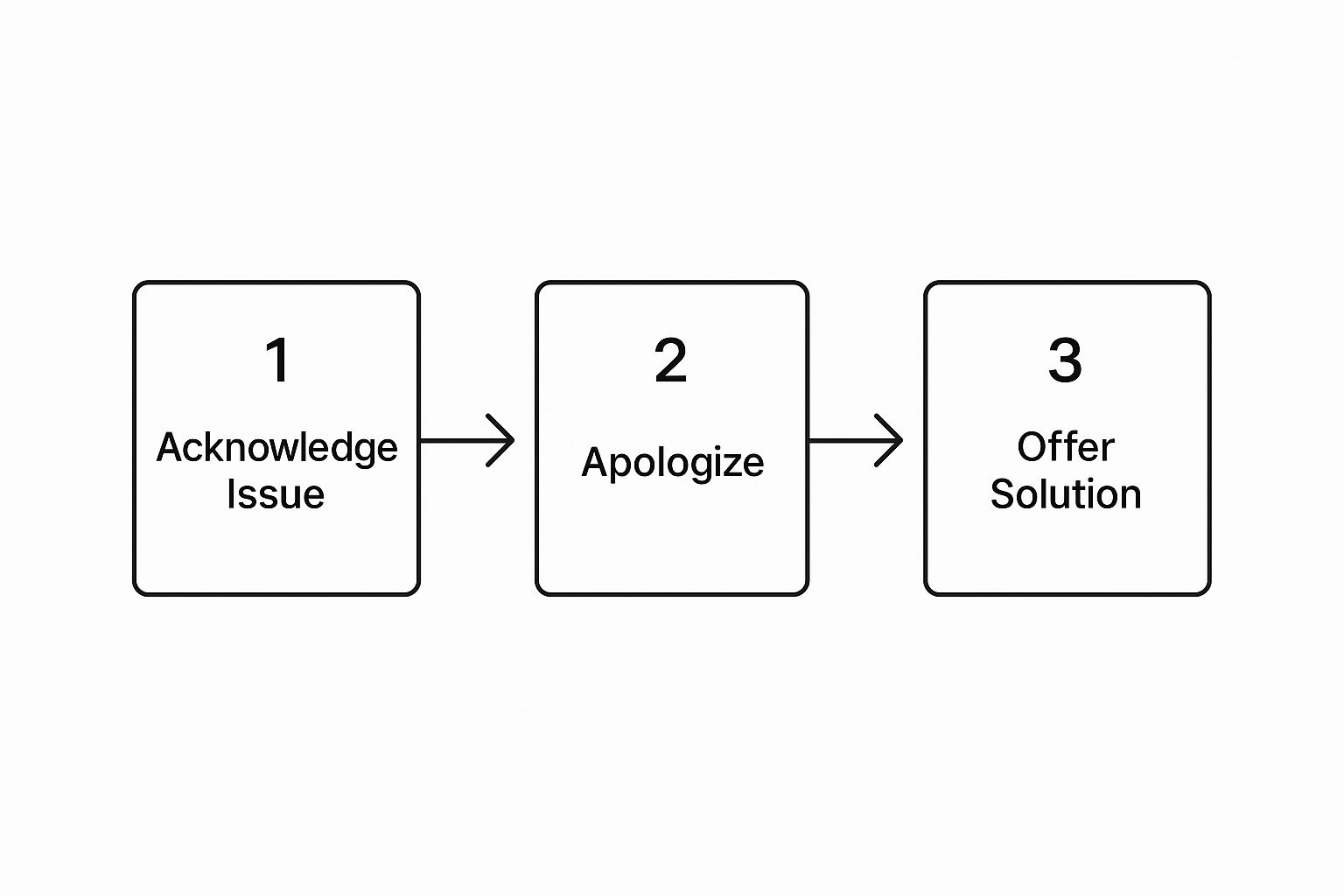When a customer leaves a negative review, it’s easy to feel a sting of frustration. But that moment is actually a golden opportunity. Responding isn’t just about damage control; it’s a direct, public way to show every potential customer that you’re committed to great service and you genuinely care.
A thoughtful, swift reply can rebuild trust with an unhappy customer and prove your transparency to everyone else watching. On the flip side, ignoring criticism comes across as indifference, which can quickly erode your brand’s credibility.
Why You Must Respond to Negative Reviews

Silence sends a powerful message, just not the one you want. It tells the original poster their experience didn’t matter. Worse, it signals to future customers that if something goes wrong, you might not be there to fix it.
This isn’t about winning a public argument. It’s about taking control of the narrative. A well-crafted response can turn a public complaint into a shining example of your professionalism and dedication to making things right. It’s your chance to acknowledge an issue, calmly explain what happened, and show the world that you are a reasonable, solution-focused business.
Turning Critics into Advocates
I’ve always seen a negative review as a stress test for a company’s customer service. When you handle it well, you don’t just neutralize a bad comment—you can create a loyal advocate. It’s a surprising but true phenomenon: customers who have a problem resolved efficiently often become more loyal than those who never had an issue in the first place.
Remember, your reply is speaking to three distinct audiences:
- The Unhappy Customer: Your top priority is to make them feel heard and respected.
- Potential Customers: They’re watching to see how you react under pressure. A great response can win their business.
- Search Engines: Active engagement with reviews signals to algorithms that your business is legitimate and values its customers.
The core principle is simple: engagement is always better than silence. Responding shows you’re present, listening, and committed to improvement. This proactive stance is fundamental to building a strong, resilient brand.
The Tangible Business Impact of a Response
Looking at the data, the importance of responding becomes crystal clear. Research shows that 53% of customers expect a business to reply to their negative review within a single week.
When businesses meet that expectation, the payoff is huge. A separate study found that when businesses take the time to respond, 45% of consumers say they are more likely to visit that business. That’s a direct line from a thoughtful reply to increased foot traffic and revenue.
To put this in perspective, here’s a quick breakdown of how responding stacks up against ignoring the problem.
| The Impact of Responding vs Ignoring Negative Reviews | ||
|---|---|---|
| Metric | Impact of Responding | Impact of Ignoring |
| Customer Loyalty | Increases trust; can turn a negative into a positive. | Decreases trust; customer feels unheard and is likely lost for good. |
| Brand Perception | Seen as transparent, caring, and professional. | Perceived as indifferent, unprofessional, or incompetent. |
| New Customer Acquisition | 45% of consumers are more likely to visit, attracting new business. | Potential customers are deterred, leading to lost sales. |
| Online Reputation | Strengthens reputation by showing accountability. | Damages credibility and lowers overall star rating over time. |
As you can see, the choice is clear. Actively managing feedback is an investment, while ignoring it is a liability.
Ultimately, your online reputation is one of your most valuable assets. You can learn more about its importance at why is online reputation important in our detailed guide. Every response you post is another brick in that foundation. Understanding the AI’s role in monitoring brand reputation with feedback can also highlight just how critical it is to engage with every customer comment to protect your brand.
Anatomy of an Effective Review Response
Alright, let’s move from theory to action. Knowing you should respond to a negative review is one thing; knowing how to do it is another ballgame entirely. Crafting the right reply isn’t about plugging a complaint into a generic template. It’s about a thoughtful, empathetic approach that proves you’re actually listening.
The best responses I’ve seen all follow a similar pattern. They’re built on a few core pillars that consistently turn a bad experience into a moment that actually strengthens the brand.
The framework is simple enough: genuinely acknowledge what happened, take ownership of the mistake (no excuses!), offer a clear solution, and then—this is key—move the conversation offline. Once you master this flow, you can handle just about any piece of feedback professionally. You’re not just putting out a fire; you’re showing everyone watching how much you care about getting it right.
Acknowledge and Validate Their Experience
Your first move should always be to show the customer you’ve heard them. And I mean really heard them. This goes beyond a canned “We’re sorry.” You need to reference the specific issue they brought up. Why? Because vague acknowledgments feel dismissive, and that’s just throwing gasoline on the fire.
Let’s say a customer complains about a “long wait and cold food.”
- Weak Response: “We’re sorry you had a bad experience.” (This is generic and feels like a brush-off.)
- Strong Response: “Thank you for letting us know about your visit. We’re truly sorry to hear that you experienced a long wait and that your food wasn’t served hot.”
See the difference? The second option validates their specific complaint. It proves you took the time to read and understand their feedback. That small act of validation can immediately de-escalate things and make the customer much more open to a resolution. It’s a sign of respect.
Acknowledging the specific issue isn’t an admission of guilt; it’s an admission that you’re listening. This critical first step builds a bridge of communication and shows both the reviewer and the public that you take customer concerns seriously.
Here’s a great visual that breaks down the fundamental flow of a strong response.

As you can see, it’s a clear progression from understanding the problem to actually fixing it.
Take Ownership and Offer a Sincere Apology
After you’ve acknowledged the specifics, it’s time to take ownership. This is where so many businesses stumble. They get defensive or use weaselly, non-committal language. A classic example is, “We’re sorry you felt that way.” That wording subtly shifts the blame, making it about the customer’s feelings rather than your service failure. Don’t do it.
A real apology accepts responsibility. Plain and simple.
It sounds like this: “We sincerely apologize for the frustration this caused,” or “We regret that we didn’t meet your expectations during your visit.” This kind of language shows accountability. It tells potential customers that you stand behind your service, even when you mess up.
Propose a Solution and Move the Conversation Offline
The final piece of the puzzle is all about action. You need to offer a clear path forward and give the customer a way to continue the conversation with you privately. This is non-negotiable. It stops a public back-and-forth and proves you’re serious about making things right.
Your goal here is simple: fix it.
- Provide a Direct Contact: Don’t just say “contact us.” Give them a specific person, email, or phone number. For instance, “Please reach out to our manager, Sarah, directly at [email] so she can learn more and personally resolve this for you.”
- Explain What’s Next: Briefly tell them what you’re doing internally. “We’re also looking into what happened with our kitchen staff to ensure our timing and food quality are where they need to be.”
Moving the conversation offline protects the customer’s privacy and lets you get the details needed to truly solve the problem. It also signals to every other person reading the reviews that your goal isn’t to argue—it’s to help. And just like that, a public complaint becomes a private, productive dialogue.
Real-World Scenarios: Putting Theory into Practice

It’s one thing to talk about the principles of a good response, but it’s another to see them in action. Let’s walk through a few common negative review scenarios and see how the right words can turn a bad experience into a public display of great customer care.
The impact here is massive. A single negative review can turn away as many as 30 customers, and research shows that 86% of consumers will steer clear of a business with bad feedback. These aren’t just numbers; they’re lost opportunities. For a deeper dive, these online reputation management statistics really highlight why a thoughtful public response is so critical.
To make this crystal clear, we’ll look at some side-by-side examples—the common mistakes versus the expert approach.
The Restaurant with Slow Service
This is a classic. A customer leaves a two-star review complaining about a long wait for their food and a server who was nowhere to be found. It’s a story we’ve all heard (or lived).
- Don’t Do This: “We are sorry you felt the service was slow. We were very busy on Saturday night and our staff does their best to keep up. We hope you’ll give us another try.”
This response immediately puts up a wall. It’s defensive (“we were busy”) and minimizes the customer’s feelings with the phrase “sorry you felt.” It takes zero ownership.
- Do This Instead: “Hi [Customer Name], thank you for taking the time to share this with us. We’re genuinely sorry to hear that your wait was longer than it should have been and that our service didn’t meet your expectations. That’s not the experience we aim to provide, and we sincerely apologize for the frustration. Based on your feedback, we’re reviewing our Saturday staffing to make sure this doesn’t happen again. We’d love a chance to make this right. Please reach out to our manager, David, at [email] so he can personally help.”
See the difference? This reply is specific, truly apologetic, and focuses on a solution. It shows you’re not just saying sorry—you’re actually doing something about it.
The E-commerce Store with a Faulty Product
An online shopper is fuming because the gadget they ordered arrived broken. They leave a one-star review calling it “cheap junk.”
- Don’t Do This: “All our products go through quality control. Damage must have occurred during shipping. Please contact customer service.”
This is a classic case of passing the buck. It blames the shipping company and gives the frustrated customer more homework. It feels cold, robotic, and completely unhelpful.
A great response doesn’t just solve the problem for one customer; it demonstrates to every potential customer that you are a business that stands behind its products and values its patrons. It’s a marketing opportunity disguised as customer service.
- Do This Instead: “Hi [Customer Name], we are so sorry your item arrived damaged. We completely understand your disappointment and sincerely apologize for this lapse in quality. We’re shipping you a replacement right away, on us, and you should see an email with tracking info within 24 hours. Please don’t worry about returning the original. We’re also pulling stock from that batch to inspect it, all thanks to you bringing this to our attention.”
This is how you respond to a negative review like a pro. It offers an instant, no-fuss solution and shows a real commitment to quality that every future customer will see.
The Service Provider with Poor Communication
A client complains that their project manager went silent for weeks, leaving them completely in the dark. This is a huge pain point for agencies, contractors, and consultants.
- Do This Instead: “Hi [Client Name], thank you for this candid feedback. We are truly sorry that our communication didn’t meet your expectations—or our own standards. Keeping our clients in the loop is a top priority, and it’s clear we failed you here. We’re using your experience as a crucial training moment for our entire team to overhaul our client update process. We would value the chance to discuss your project further and regain your trust. Please contact me directly at [email].”
This response is perfect. It validates the client’s feelings, takes complete ownership without excuses, and outlines a concrete internal change. It turns a valid complaint into a public promise for improvement.
Handling Difficult and Unfair Reviews

Let’s be honest, not every negative review is a straightforward, constructive critique. Some are just plain difficult. You’ll run into reviews that are emotionally charged, packed with incorrect information, or so vague you have no idea what went wrong.
These are the moments that truly test your professionalism. It’s easy to get defensive, but how you handle these tough situations is a massive opportunity. You get to show every potential customer watching just how committed you are to getting things right.
The goal isn’t to win an argument—it’s to de-escalate, respectfully clarify the facts, and prove you’re a reasonable, customer-first business, even under pressure.
Correcting Misinformation Without Sounding Defensive
It’s infuriating when a review gets the facts completely wrong. Maybe a customer claims you don’t offer a service that’s central to your business or completely misstates a policy. The temptation to fire back with a blunt correction is strong, but that approach almost always comes off as aggressive.
A softer, more diplomatic approach works much better. Frame your correction as a helpful clarification, not a public takedown.
- Here’s a common scenario: “This cafe is a total rip-off! They claim to have gluten-free options, but they don’t.”
- And a much better response: “Hi [Customer Name], we’re so sorry to hear you had a frustrating visit. We wanted to clarify for you and anyone else reading that we do have a dedicated gluten-free menu, including our almond flour scones and quinoa salads. We sincerely apologize if this wasn’t made clear, and we’re using your feedback to retrain our staff to always highlight these options.”
See the difference? This response corrects the record without ever accusing the customer of lying. It immediately pivots to a solution and shows you’re taking their experience to heart.
The most powerful response to misinformation isn’t a direct confrontation, but a helpful clarification. Remember, you’re not just speaking to the original reviewer; you’re educating every future customer who reads that exchange.
Dealing with Highly Emotional or Vague Reviews
Some reviews are pure emotion. The customer is furious, or they drop a one-star bomb with a comment like, “Just awful.” When you’re faced with raw anger or a frustrating lack of detail, your first job is to lead with empathy and move the conversation offline.
You can’t solve a problem you don’t understand. When a review is vague, acknowledge their bad experience and invite them to share the details privately. This simple act shows you actually care enough to investigate.
For those intensely emotional reviews, validation is your best friend. Before you do anything else, acknowledge their frustration. Phrases like, “That sounds incredibly frustrating,” or “We completely understand why you’re upset,” can work wonders.
Here’s a quick breakdown of how to approach these tricky situations:
| Review Type | The Main Challenge | Your Best Strategy |
|---|---|---|
| Factually Incorrect | Fighting the urge to argue and prove them wrong. | Politely provide the correct information and pivot to a helpful, solution-oriented tone. |
| Highly Emotional | The customer is upset and isn’t focused on a practical solution. | Acknowledge their feelings first. Use phrases like, “We understand your frustration.” |
| Frustratingly Vague | You have no specific details to work with. | Apologize for the poor experience and invite them to provide more details through a private channel. |
Of course, some reviews cross a line. If you encounter a review that uses harassing language or contains provably false claims, it might violate the platform’s policies. In those cases, you may be able to get it removed. We walk through that exact process in our guide on how to dispute a google review.
Mastering the art of handling these difficult reviews takes a steady hand, but it’s a skill that will protect your reputation and build incredible trust with your audience.
Turn Negative Feedback into Your Best Business Insight
When you’re staring down a negative review, it’s easy to get tunnel vision and just focus on damage control. But if you take a step back, you’ll see that you’re looking at a free, unfiltered source of business intelligence. The most successful businesses I’ve seen don’t just react to complaints; they treat them as gifts of insight that can spark real, meaningful improvements.
Every piece of feedback is a data point. Once you start treating it that way, you can stop just reacting to individual problems and start proactively making your entire customer experience better. It’s a fundamental shift in mindset, and it’s the key to building a business that lasts.
From Individual Complaints to Actionable Data
So, how do you make that shift? You start by looking for patterns. Instead of seeing each bad review as a separate incident, connect the dots.
One customer complaining about slow service could just be a one-off. But if you get three similar comments in a week? That’s not a customer problem anymore. That’s an operational red flag, pointing to a potential staffing shortage or a broken process that needs your attention.
Building a system to track these trends is simpler than it sounds. You don’t need a fancy setup right away—a basic spreadsheet can work wonders.
- Categorize the Feedback: Start by bucketing comments into common themes. Think “Product Quality,” “Staff Attitude,” “Shipping Delays,” or “Cleanliness.”
- Track Frequency: Keep a simple tally of how often each category pops up over weeks and months.
- Identify Root Causes: Let the data tell the story. If “Staff Attitude” is a recurring theme, it’s probably time to invest in better customer service training.
This process transforms scattered complaints into hard data, giving you the clarity to fix the real problem. For a more detailed look at this approach, it’s worth understanding the core principles of analyzing customer feedback for business growth.
Closing the Feedback Loop
After you’ve spotted a pattern and made a change, there’s one crucial step left: you have to “close the loop.” This is all about communicating the improvements you’ve made, sometimes right there in your public review responses.
By turning unstructured feedback into structured data, you can stop putting out individual fires and start reinforcing the foundation of your business. This strategy leads to fewer negative reviews over time because you’re actively eliminating the reasons for them.
Let’s say a customer leaves a review mentioning your gym’s old, squeaky treadmills. After you’ve upgraded the equipment, your response to a similar review could be: “Thank you for highlighting this. Based on your feedback and that of other members, we’re excited to announce we’ve replaced all our treadmills.”
This single sentence proves to past, present, and future customers that you don’t just listen—you act.
As you grow, managing this process manually can get tricky. That’s when many businesses turn to specialized customer feedback management software to help track trends and keep responses consistent. It’s an investment in building a stronger, more resilient business from the ground up.
Answering Your Toughest Questions About Negative Reviews
When you’re staring down a one-star review, a lot of questions can race through your mind. It’s a tricky situation, for sure. Let’s walk through some of the most common dilemmas business owners face and figure out the best way forward.
Do I Really Have to Respond to Every Single Bad Review?
In a word, yes. Well, almost every single one. The goal is to show both the unhappy customer and anyone else reading that you’re engaged and that you care. Consistency is everything here.
The only real exception is when a review crosses a line and violates the platform’s policies—think hate speech, spam, or completely irrelevant rants. In those rare cases, your first move should be to report the review. Wait to see what the platform decides before you even think about writing a public reply.
How Fast Do I Need to Be?
You’ll want to aim for a response within 24 to 48 hours. Time is of the essence. A quick reply shows you’re on top of things and take customer feedback seriously. It stops a bad situation from getting worse in the public eye.
A timely response can often de-escalate a customer’s frustration. The longer a negative comment sits unanswered, the more it signals to the public that you might not care about fixing problems.
Leaving a negative review hanging for days sends a message that you’re either disorganized or, worse, that you just don’t care.
What if the Review Is Just Plain Wrong or an Outright Lie?
This is probably the toughest scenario. Your gut instinct might be to jump in and set the record straight, fact by fiery fact. But trust me, that’s a fight you’re unlikely to win in a public forum. It just looks like a messy argument.
Instead, take a deep breath and handle it with professional grace. You don’t want to accuse them of lying, but you can gently correct the record.
- Politely clarify what you can. Something like, “We’re sorry for any confusion on this. Our records show something a little different, and we’d love to clear it up.”
- Keep your reply short and sweet. Don’t get dragged into a long, drawn-out debate.
- Get the conversation offline. The magic phrase is always something like, “We take this seriously and would appreciate the chance to discuss it with you. Could you please reach out to us at [email/phone]?”
This approach shows potential customers that you’re the reasonable one, even when you’re faced with a tough, and potentially unfair, situation.
Keeping up with your online reputation is a full-time job, but the right tools can make it a whole lot easier. Reviews To The Top brings all your review management into one place, so you can respond faster, encourage more positive feedback, and use those customer conversations to grow your business. Find out how we can help you today.
